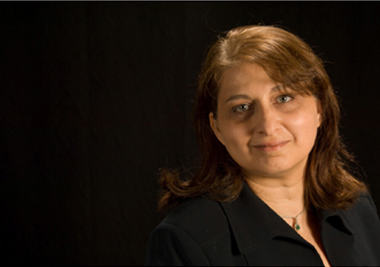UAlbany Report: Number of Women Judges Rises, but Equal Representation is Elusive Goal
Vermont ranks first in nation in percentage of women on federal and state benches; Idaho ranks last
 Read the complete document
Read the complete document
 |
|
Dina Refki, executive director of the Center for Women in Government and Civil Society, was the project director. (Photo Mark Schmidt) |
The number of women holding federal and state-level judgeships across the nation continues to inch forward, a University at Albany study has found. However, no state has achieved equal representation of women (50 percent of all seats) in either federal or state-level judgeships.
A report by UAlbany’s Center for Women in Government & Civil Society (CWGCS), of the Rockefeller College of Public Affairs and Policy finds that, nationwide, women make up 23 percent of all federal judgeships and 27 percent of all state-level positions. This represents an overall one percent increase from 2010 levels, which were 22 percent and 26 percent, respectively.
In 2011, women accounted for 26.6 percent of both federal and state judgeships. Since 2010, women’s share of federal and state judgeships has increased in 33 states, remains at the same levels in 11 states, and has decreased in 7 states.
“We are encouraged that we are seeing progress, but at the same time progress has been so slow and not consistent with the number of women qualified to serve on the bench,” said Dina Refki, executive director of CWGCS and project director. “When we consider that the pool of qualified female candidates is as large as the pool of male candidates, the pace of progress is unjustified.”
In state-level judgeships, no state has achieved equality, but seven states and the District of Columbia have achieved a threshold of 33 percent women judges, the study found. The 33 percent threshold is the point where women become a critical mass, and where their presence becomes significant enough to change stereotypical concepts of gender roles, said Refki.
In federal judgeships, that threshold was achieved or exceeded in only three states – New Jersey (44.4 percent), Vermont (40 percent) and Connecticut (38.1 percent), the report found. Women’s share of federal judgeships was between 20 and 29 percent in 28 states, according to the report. It was below 10 percent in four states, Mississippi, Montana, North Carolina, and South Dakota.
“We tend to underestimate the importance of having equal representation of women on the bench,” said Refki. “It is critical to have a judicial system that is representative of the people it serves. When people feel that the system represents them, they are more likely to have trust and confidence in its ability to be just and fair to them, and are less likely to feel alienated from it. These are the goals of any democratic society.”
Vermont retained its first place ranking in terms of the percentage (39.6 percent) of women on federal and state benches. Idaho retained its 2010 last place ranking with 11.3 percent of seats on federal and state benches occupied by women. New York ranked 12th among other states with respect to the percentage of women on both federal and state benches, improving from its 14th place ranking in 2010.
The source for the study was the 2011 edition of The American Bench: Judges of the Nation produced by Foster and Lang.
The Center for Women in Government & Civil Society is a cornerstone of women’s leadership development, an academic research center, and a policy think tank that generates knowledge and provides analysis on issues facing women and girls.
![]() For more news, subscribe to UAlbany's RSS headline feeds
For more news, subscribe to UAlbany's RSS headline feeds
Educationally and culturally, the University at Albany-SUNY puts "The World Within Reach" for its 18,000 students. An internationally recognized research university with 58 undergraduate majors and 128 graduate degree programs, UAlbany is a leader among all New York State colleges and universities in such diverse fields as public policy, nanotechnology and criminal justice. With a curriculum enhanced by 300 study-abroad opportunities, UAlbany launches great careers. For more information about this globally ranked University, visit https://www.albany.edu/. For UAlbany's extensive roster of faculty experts, visit www.albany.edu/news/experts.shtml.




